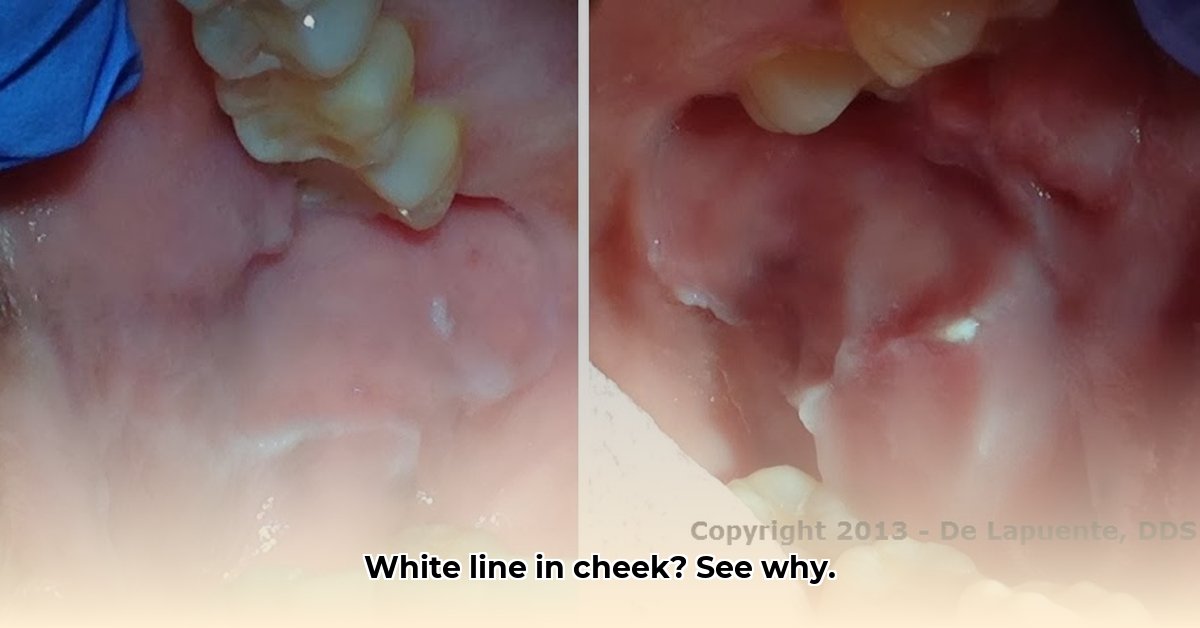Have you noticed a thin, white line inside your cheek? You’re not alone. This common occurrence is likely linea alba, a harmless condition typically caused by friction. This guide will explain what linea alba is, its causes, and when you should seek professional advice.
What is Linea Alba?
Linea alba (literally “white line”) is a harmless thickening of the mucous membrane inside your cheek, often appearing where your top and bottom teeth meet. It’s essentially a small, internal callus, similar to how calluses form on your hands from repeated rubbing. While usually painless, it can sometimes feel slightly raised or rough. This thickening results from increased keratin production, the same protein that makes up your fingernails and hair. See an image of linea alba
Why Does Linea Alba Develop?
Several factors can contribute to the friction that causes linea alba. Some common culprits include:
- Cheek biting or chewing: Particularly common during stress or anxiety.
- Teeth grinding (bruxism): This often occurs unconsciously during sleep.
- Misaligned teeth (malocclusion): Crooked or crowded teeth create uneven pressure points.
- Dental appliances: Ill-fitting dentures, braces, or retainers can rub against the cheek.
- Aggressive oral hygiene: Brushing too hard or using abrasive toothpaste can irritate the delicate cheek tissue.
- Sharp tooth edges or restorations: These can cause chronic irritation.
- Other habits: Chewing on pens, pencils, or other objects can contribute to friction.
Recognizing Linea Alba: Symptoms and Diagnosis
Linea alba typically appears as a thin, horizontal, white line inside the cheek, often on both sides of the mouth. Usually, it’s painless and the only noticeable symptom. A dentist or doctor can easily diagnose linea alba with a simple visual examination.
Could It Be Something Else?
While linea alba is generally harmless, it’s important to differentiate it from other conditions that may appear similar. A professional examination is crucial to rule out more serious possibilities like:
- Leukoplakia: Thickened, white patches that can sometimes be precancerous, particularly in tobacco users. Leukoplakia cannot be scraped off, unlike linea alba. See an image of leukoplakia
- Oral Lichen Planus: A chronic inflammatory condition characterized by lacy-white patches or sores, often accompanied by discomfort or a burning sensation. See an image of oral lichen planus
- Oral Thrush (Candidiasis): A yeast infection causing creamy, white patches that can be wiped away, revealing red, irritated tissue underneath. See an image of oral thrush
- Frictional Keratosis: Similar to linea alba but typically thicker and more persistent. It may require surgical removal if it becomes bothersome. See an image of frictional keratosis
- Canker Sores: Small, painful ulcers, usually solitary, often appearing on the inside of the lips or cheeks. See an image of canker sores
- HPV Lesions (Oral Warts): While less common, HPV can manifest as warts or other unusual growths in the mouth. See an image of HPV Lesions
- Chemical or thermal burns: These can result in white patches or lesions and may result from certain foods, medications, or other substances.
Here’s a table summarizing the key differences:
| Condition | Appearance | Symptoms |
|---|---|---|
| Linea Alba | Thin, white line, often bilateral | Usually painless |
| Leukoplakia | Thickened, white patches, cannot be scraped off | May be painless or cause burning |
| Oral Lichen Planus | Lacy, white patches or red sores | Burning, pain, sensitivity |
| Oral Thrush | Creamy, white, wipeable patches | Pain, burning, cottony feeling |
| Frictional Keratosis | Thickened white patches | Usually none, may feel rough |
| Canker Sores | Small, painful ulcers | Pain, burning, tingling at ulcer site |
Treating and Preventing Linea Alba
In most cases, linea alba requires no treatment and resolves once the underlying friction is addressed. Here are some preventive measures:
- Manage Stress: If cheek biting is the cause, explore stress-reduction techniques like meditation, deep breathing, or exercise.
- Address Dental Issues: See your dentist to adjust ill-fitting dentures or braces. Consider using dental wax to protect your cheek from irritation.
- Improve Oral Hygiene Habits: Use a soft-bristled toothbrush and avoid aggressive brushing. Consider switching to a less abrasive toothpaste.
- Mouthguard for Bruxism: If you grind your teeth, your dentist may recommend a custom-fitted mouthguard.
- Be Mindful of Habits: Avoid chewing on pens, pencils, or other non-food items.
- Orthodontic Treatment: If the cause is malocclusion, orthodontic treatment might be beneficial.
When to See a Doctor
While linea alba is usually benign, consult a doctor or dentist if:
- The white line persists or changes in appearance (color, thickness, texture).
- You experience pain, bleeding, numbness, or persistent sores.
- You notice any other unusual changes in your mouth, especially if you use tobacco products.
Frequently Asked Questions (FAQs)
- Is linea alba contagious? No, linea alba is not contagious.
- Will linea alba go away on its own? Yes, it typically resolves once the source of friction is removed.
- Is linea alba a sign of cancer? No, linea alba itself is not cancerous or precancerous. However, it’s essential to have any persistent white lesions in your mouth examined by a professional to rule out other conditions.
Reassurance and Conclusion
Linea alba is a common and generally harmless condition. By understanding its causes and characteristics, you can take appropriate steps to manage it and know when to seek professional advice. This information is for educational purposes and does not substitute professional medical advice. Always consult with a healthcare professional for any concerns about your oral health.
- Mini Bento Boxes For Packing Kids Snacks And Small Meals - December 27, 2025
- Small Bento Box Makes Packing Lunch Easy and Fun Again - December 26, 2025
- Adult Bento Box Lunch Ideas For Quick Healthy Portable Options - December 25, 2025










